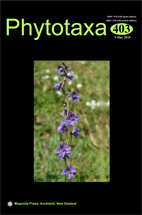Abstract
The phylogenetic relationships of 12 Hylodesmum species and closely related genera were reconstructed using maximum parsimony, maximum likelihood, and Bayesian analyses based on two chloroplast DNA regions (rps16-trnQ and trnL-F) and one nuclear marker (internal transcribed spacer, ITS). All analyses yielded reliable relationships among the major lineages within Hylodesmum, suggesting that Hylodesmum is monophyletic. Neither the traditionally defined Desmodium sect. Podocarpium nor D. sect. Repanda within the genus was supported as being monophyletic based on the ITS analyses and the combined ITS and chloroplast dataset analyses. The phylogenetic topologies indicated that the three species included in D. sect. Repanda were separated into different clades, which suggested that D. sect. Repanda is paraphyletic. Generally, the clades retrieved by phylogenetic analyses within D. sect. Podocarpium were consistent with traditionally defined groups except for the American group. The molecular analysis provides information regarding the revision of the traditional taxonomic system of Hylodesmum and for the evaluation of the systematic positions of each species within the genus Hylodesmum.

